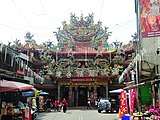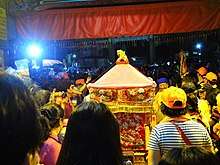Baishatun Mazu Pilgrimage
The Baishatun Mazu Pilgrimage (Chinese: 白沙屯媽祖進香; pinyin: Báishātún Māzǔ jìnxiāng) usually holds between lunar January and April annually in western plain of Taiwan, which was a big Taoist folk event since 1863. After every lunar new year, the Mazu statue of Gongtian Temple (Chinese:拱天宮) at Baishatun, Tongxiao of Miaoli County, it sits in the palanquin to visit another Mazu Temple- Chaotian Temple (Chinese: 朝天宮), where is at Beigang of Yunlin County, then returns to Gongtian Temple as ending this pilgrimage, the distance is approximately 400 KM totally.[1]
There is another Mazu statue, called as "Mazu the Mountain Side (Chinese:山邊媽祖; pinyin: Shān-biān māzǔ)", who is from Houlong Township (Chinese:後龍鎮) of Miaoli county would accompany Baishatun Mazu finishing the pilgrimage as well. [2]
Feature
Mazu, also spell as "Matsu", known as a sea goddness for blessing the fishermen and safe journey during the sailing, there are a lot of believers in Taiwan because of her mercy image. [3]So, Mazu pilgrimage is one of the popular religious activities in Taiwan.[3]
During the whole pilgrimage, Mazu's palanquin carriers go forward only on foot, many pilgrims would follow the steps of Mazu's palanquin, the most traditional way is following by walking, but still plenty of the pilgrims would by scooters, cars, or bicycles. Moreover, the duration and route of Baishatun pilgrimage are not the same in the different year, such as 6 days 5 nights in 2009, or there were 12 days 11 nights in 2017, too.[4]
The most unique feature of Baishatun pilgrimage is the route. No matter what the way of departing or returning, the route is unpredictable in advance.[5] According to the Mazu's palanquin carriers, they said they could feel Mazu's will and indicated them where was the next direction or where to stop while they were walking, pilgrims only know the location of origin and destination.[1][5] Therefore, people regard the Baishatun Mazu Pilgrimage as the most challenge one in Taiwan.
Gallery
- Baishatun Mazu Staute (Pink-faced)
 Baishatun Gongtian Temple, Tongxiao, Miaoli County
Baishatun Gongtian Temple, Tongxiao, Miaoli County The pilgrims
The pilgrims By tradition, residents offer free supplies to pilgrims.
By tradition, residents offer free supplies to pilgrims. Baishatun Mazu's palanquin
Baishatun Mazu's palanquin Beigang Chaotian Temple, Yunlin County
Beigang Chaotian Temple, Yunlin County
References
- 1 2 "白沙屯媽祖徒步進香". 臺灣宗教百景 (in Chinese). Retrieved 2018-05-22.
- ↑ "就是要一起走 山邊媽與白沙屯媽的百年情誼". Boobee Now (in Chinese). 2018-05-27. Retrieved 2018-09-13.
- 1 2 Lin, Maoxian (2016-03-20). "臺灣人為何瘋媽祖?媽祖文化隱含著母親意象". 民俗亂彈 (in Chinese). Retrieved 2018-05-23.
- ↑ "白沙屯媽祖婆網站" (in Chinese). Retrieved 2018-05-22.
- 1 2 "沒固定路線、全憑神轎指引徒步400里…白沙屯媽祖進香有何秘密?他爆出這些「神蹟」超驚奇". The Storm Media (in Chinese). 2018-04-19. Retrieved 2018-05-23.
External links
| Wikimedia Commons has media related to Baishatun Mazu Pilgrimage. |
- Baishatun Mazu Pilgrimage Official Information
- Baishatun Gong Tian Temple (English Website)
- Baishatun Matsu Internet TV on YouTube
- Baishatun Gongtien Temple on Facebook